A WiFi box, often referred to as a router or gateway, is the central hub of your home network. It connects your internet service to your devices, allowing you to access the online world. This essential piece of hardware is responsible for distributing internet signals throughout your home.

The Role of the WiFi Box
- Internet Connection: The WiFi box acts as a bridge between your internet service provider (ISP) and your home network.
- Wi-Fi Signal Distribution: It broadcasts a wireless signal that enables multiple devices to connect to the internet simultaneously.
- Network Management: The WiFi box allows you to configure network settings, such as Wi-Fi name, password, and security.
- Device Connectivity: It enables the connection of wired devices like computers, game consoles, and smart TVs.
Types of WiFi Boxes
There are several types of WiFi boxes available, each with its own characteristics:
- Cable Modems: These devices are commonly used with cable internet services and combine the functions of a modem and router.
- DSL Modems: Specifically designed for DSL internet connections, these boxes convert digital signals into data that can be accessed by your devices.
- Fiber Optic Modems: Used for fiber internet services, these modems convert light signals into electrical signals for your network.
- Standalone Routers: These devices can be used with any internet connection type to create a wireless network.
Optimizing Your WiFi Box for Better Performance
To get the most out of your WiFi box, consider the following tips:
- Placement: Position your WiFi box in a central location to maximize coverage. Avoid placing it near obstacles like walls or large metal objects.
- Firmware Updates: Keep your WiFi box firmware up-to-date to benefit from the latest features and security enhancements.
- Network Security: Use a strong password and enable encryption to protect your network from unauthorized access.
- Guest Network: Create a separate guest network for visitors to prevent unauthorized access to your main network.
- Channel Selection: Choose the optimal Wi-Fi channel to minimize interference from neighboring networks.
Troubleshooting Common WiFi Box Issues
If you encounter problems with your WiFi box, try these troubleshooting steps:
- Restart Your Router: Turn off your WiFi box and modem, wait for a few minutes, then turn them back on.
- Check Cable Connections: Ensure all cables are securely connected to your WiFi box and modem.
- Update Device Drivers: Make sure your computer’s network drivers are up-to-date.
- Reset Your Router: If necessary, perform a factory reset on your WiFi box, but be aware that this will erase all custom settings.
The Future of WiFi Boxes
As technology advances, WiFi boxes are becoming increasingly sophisticated. Mesh Wi-Fi systems, which consist of multiple interconnected nodes, are gaining popularity for providing better coverage in larger homes. Additionally, integration with smart home devices and the Internet of Things (IoT) is expanding the capabilities of these devices.

Conclusion
The WiFi box is a crucial component of modern home networking. By understanding its functions and optimizing its performance, you can enjoy a seamless internet experience. As technology continues to evolve, we can expect even more advanced WiFi boxes to emerge, offering enhanced features and improved connectivity.
لا تعليق